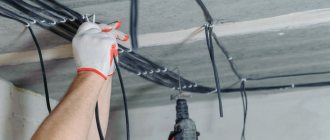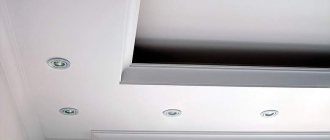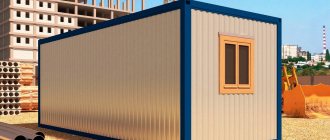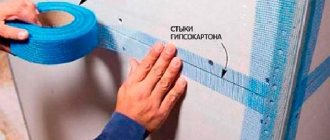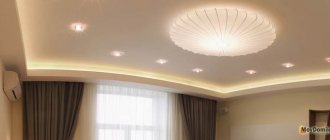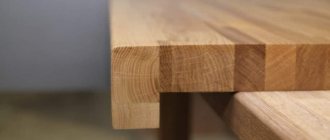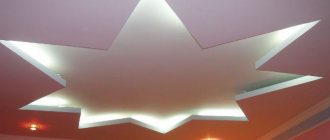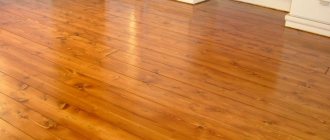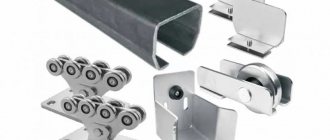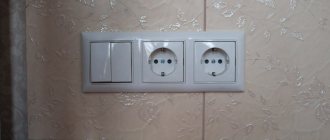Installing drywall on walls and ceilings is a fairly simple job that you can do yourself. Installation of plasterboard is carried out on the ceiling or walls on the wall using a profile. Drywall is a material that will allow you, quite independently, quickly and easily, with minimal investment of time and money, to level and prepare walls for further finishing in any room of a wooden, brick or panel house. We will tell you in our article how to install drywall on walls and ceilings correctly so that they are not only smooth, but also durable.
Drywall: scope
Drywall has long gained popularity as a flexible and versatile material for construction and repair. Installing drywall is not as complicated as it may seem at first glance. It is enough to understand some rules and nuances.
Drywall is a sheet made from gypsum. It can be in size 1.2*3 m or 2.5*1.2. The material is covered on both sides with thick cardboard. Because of this composition, it is considered environmentally friendly. But during manufacturing, additives can be used to impart certain qualities to the building material: moisture resistance, heat resistance.
When performing repair work, plasterboard can be used for the following purposes:
- Insulation of premises.
- Construction of partitions, walls, niches, various complex structures.
- Leveling surfaces. It is worth noting that this is a fairly economical and fast method.
Final putty
If the walls were prepared for tiles, thick wallpaper, etc., then you don’t have to proceed with the subsequent puttying, but immediately proceed to applying finishing materials. If the installation of drywall initially meant glass wallpaper or thin painting, then you will have to tinker with the finishing putty.
Gypsum plaster “Starateli”, packing 30 kg
Finishing putty can be considered one of the most labor-intensive or, if you like, tedious processes of working with dry gypsum plaster. At this stage, ineptly applied layers of putty can delay the progress of repairs for a long time, or even completely nullify all previous work.
All types of putty mixtures can be divided into starting, finishing and universal. Finishing putty mixtures are made on the basis of polymer materials, and with their help you can obtain perfectly flat and smooth surfaces. However, even such putty (if the surface is being prepared for painting) requires careful cleaning using sandpaper and a plaster trowel.
No matter how deft and confident the movements of the spatula are, there will always be traces of “strokes”, bumps, unevenness, etc. on the putty. Moreover, if the surfaces are left as is, and not cleaned before painting, then in the light of the ceiling lamp, due to the play of chiaroscuro, all defects will appear. Therefore, if you want to achieve not just a flat, but a perfectly flat surface of the walls and ceiling, it is better to grind the putty “under the light.”
When the surfaces of the walls and ceiling are completely cleaned, you can begin priming and painting them. These operations can be performed using a spray gun or a regular paint roller.
The technology of installing drywall requires certain skills and practice, but it can also be mastered by non-professional construction workers.
Drywall installation - what you need to know
Installation of drywall is carried out in several ways:
- Apply strong special glue to leveled surfaces. Next, you will need a finishing finish, for example, dry plaster. It is not recommended to use it to make wood surfaces even.
- On a pre-prepared frame. With a similar installation, it can also be used for wooden floors. The frame can be made of either metal or wood.
Wooden bases are cheaper, since only blocks of wood are required for execution. Metal ones are made from galvanized profiles, special hangers, and connecting elements. This is a more reliable and durable option.
Before starting installation, you should familiarize yourself with several rules:
- The joints of the sheets are placed strictly on the frame and fixed with self-tapping screws.
- The seams must be taped with joining tape.
- External corners are closed with special corners.
- Interior partitions are mounted in two parallel layers.
Reinforcement of new walls
Rectangular joint between sheets of plasterboard reinforced with sickle and putty
When the intermediate frame for drywall is installed and all the sheets are mounted, it is necessary to reinforce the new walls and ceiling of the room. All internal and external corners, as well as all joints, are reinforced. The purpose of reinforcement is to increase the resistance of the structure to potential deformations caused by the same changes in temperature and humidity.
Plasterboard systems are reinforced using “serpyanka” - an inextensible mesh tape on a fiberglass base. “Serpyanka” is used to cover all weak spots and putty them with the so-called “suture putty” (special high-strength joint putty). If the external corners are located in areas that are especially dangerous for mechanical damage (for example, a doorway), then it is better to reinforce them with a special perforated corner profile.
“Serpyanka” has a certain width and is intended for local reinforcement, for example, for reinforcing the joints of adjacent sheets. If, when installing drywall, it is necessary to strengthen the entire surface, they resort to fiberglass mesh.
When the joint putty is completely dry, it is sanded with regular emery cloth flush with the main surface of the plasterboard sheet.
Installation of drywall on walls - technology
It can be noted that the sequence of installation of gypsum boards on surfaces made of various materials is approximately the same:
- the frame must be leveled;
- the guides are attached specifically to the wall surface with the same pitch;
- racks are used as load-bearing components;
- the frame can be supplemented with guide profiles to increase reliability;
- frame elements are placed at a distance of 0.4-0.6 m;
- A gap of 1-1.5 cm should be left from the floor and ceiling.
Video: installing drywall on walls
There are a number of differences in fastening drywall, taking into account the material of the walls:
- The sheets are attached to the concrete wall using a hammer drill and 60 mm dowel nails.
- The correct installation of drywall to a brick wall is carried out in the same way, but the quality and strength of the masonry should be taken into account. For old buildings and those made of hollow bricks, dowel-nails with a length of more than 80 mm are used.
- The frame is mounted on foam blocks using pancake screws without preparing holes.
- If the wall is made of wood, then fastening occurs with nails or self-tapping screws. A frame must be built on curtains with a stroke of up to 6 cm.
Marking
Plasterboard niche for central heating battery
The installation of drywall begins with a fairly simple operation - marking the room using a construction water level, plumb lines, “slaps” (painting cords), tape measures, etc. First, the room is marked around the perimeter, and then they move on to the so-called internal markings. At this stage, the installation locations of the profiles, the places of their connections and intersections, the area of the sheets are marked, the amount of auxiliary materials is calculated, etc.
DIY drywall installation: 14 rules for successful installation
Experts identify a number of rules that will help to carry out repair work correctly:
- Accurately determine the position. Be sure to mark with chalk, cord or pigment. How the installation itself will proceed depends on this.
- Install profiles correctly. They must be insulated from the floor with some kind of elastic material. This will provide sound insulation. Foam, felt, rubber, cork are suitable.
- When measuring the length of the posts, subtract the thickness of the soundproofing material. Additionally, a gap of 1.5-2 cm is made.
- When installing wall partitions, the openings should be strengthened. A rigid profile is suitable for this.
- The slabs must be carefully trimmed. A line is drawn on the outside of the sheet - where there is no print, and there are chamfers at the ends for connection.
- Sheets should be attached carefully. Phosphated screws are used for this. They are not prone to corrosion due to contact with gypsum. The cap is hidden in a sheet of 0.5 mm, and then filled with putty. There should not be too much putty between the sheets, as this will lead to cracks.
- Avoid using additional elements. You should immediately take as a basis sheets whose size is slightly larger or corresponds to the required one.
- The need for insulation and sound insulation should be considered in advance.
- When installing plasterboard walls, the layout on the second side must be offset so that the seams do not coincide.
- The seams must be puttied. In this case, the mixture must be pressed as deeply as possible and smoothed out on top.
- It is necessary to select the correct reinforcing tapes taking into account their purpose.
- To avoid deformation, do not make joining seams in the middle of doorways.
- To cut niches and openings, you need to use gypsum board crowns.
- It is recommended to start attaching sheets from the center or corner.
general information
By plasterboard sheet (GKL) we mean a rigid facing board, with which you can organize interior partitions and level the rough base on ceilings, walls, inside window and door openings, etc. GCR is also called “gypsum board” or “dry plaster”. The structure of the sheets resembles a pie, where a uniform layer of gypsum solid solution is placed between two outer layers of thick cardboard of small thickness.
Plasterboard sheets have a number of specific characteristics that must be taken into account during work:
- The presence of a uniform matte surface. This significantly facilitates the finishing of the base created in this way using putty, paint, tiles, wallpaper, decorative plaster, etc.
- Cheapness. The cost of gypsum plasterboard is an order of magnitude lower than that of other wall materials - brick, monolithic concrete, aerated concrete.
- Ease. The light weight of the material makes it possible to avoid a significant increase in the load on the building foundation and simplifies the fastening procedure during installation of a plasterboard ceiling. This explains the wide popularity of gypsum boards in interior construction.
- Fire safety. The mineral layer is a completely non-flammable material. The components included in its composition do not contain toxic substances harmful to health, which allows you to safely use plasterboard cladding in children's rooms and bedrooms.
- Good rigidity due to the use of a composite board structure. At the same time, they are characterized by some flexibility and elasticity. The combination of these qualities makes it possible to sheathe large rectilinear bases using gypsum boards and create interior compositions with a curved configuration. We are talking about decorative bay windows, cornices, counter-laced lighting, etc.
- The presence of a certain distance between the plasterboard surface and the rough base. Electrical cables, ventilation ducts, television wiring, etc. are often laid inside the resulting void. From the outside, these communications are completely invisible.
- Reducing the area of the room. Ceiling and wall plasterboard structures are mounted on a supporting metal frame of some thickness. This leads to a reduction in living space (from 5 cm on each surface), which should be taken into account when decorating small rooms.
- Fear of moisture. Gypsum plasterboards are not a moisture-resistant material: under its influence, the material gets wet and gradually collapses. You should avoid using gypsum boards in damp areas, such as a bathhouse, bath or shower.
For the manufacture of cardboard covering sheets, natural cellulose substance is used. As a result, in conditions of cold, poor ventilation and high humidity, it becomes an ideal environment for the reproduction and growth of fungus and mold. To avoid such phenomena, it is necessary to take care of suitable operating conditions for the cladding, with mandatory ventilation of the inter-ceiling space.
Installation of drywall on walls and ceilings using metal profiles
Marking for the frame
The action is carried out using a painting cord. A straight line is marked on the floor, which is the boundary of the frame. Then it is duplicated on the ceiling using a plumb line, a level and a pencil cord. Strictly vertical lines are drawn on the walls for mounting rack elements. The pitch is measured so that the joints fall in the middle of the rack profiles. Typically it is 600 mm.
Installation of guides
Installation of the frame is the next step. The horizontal profile guides on the side that will be adjacent to the base are covered with a special sealant. Its role is played by the tape. It is this that provides sound insulation. After this, drill holes for the dowels. A profile with insulation is attached to them.
The guides must securely hold the drywall, so between the screws you need to choose a step in the range of 50-100 cm. Each segment is attached in at least three places.
Attaching gypsum boards to the frame
After assembling the frame, plasterboard sheets are installed. Each panel must be firmly fixed to a metal profile base.
- It is important to carefully join the parts in the corners and among themselves to avoid distortions.
- To fix the sheets, self-tapping screws with wide heads and special crab connectors are used.
- If necessary, gypsum board panels are cut to the required dimensions.
- It is best to do this with an ordinary stationery knife, then the cut will be smooth and not crumble.
It is enough to make an incision and then simply break the sheet in this place. Drywall breaks easily at a thin cut.
How to glue drywall
The sheets are attached to flat surfaces using specialized glue. This is the easiest and fastest installation method. But it is only suitable for leveled surfaces. A difference of no more than 20 mm is allowed. This takes up less room space. There are two ways to fasten sheets:
- On clean and primed walls.
- On strips of Perlfix glue 10 cm wide.
Drywall should be fixed only after the wires have been laid and sound insulation has been thought out. Glue is applied around the perimeter and in the middle of the sheet. To ensure uniform application, use a notched trowel. After the glue has hardened, you can strengthen the structure with dowel nails.
You can also attach drywall to polyurethane foam. In this case, the sheets are attached to long screws, and the gaps are filled with foam.
Support frame
Based on the finished markings, the perimeter of the room is finished with a solid line of the “UD” guide profile. This is done using self-tapping screws and plastic dowels immersed in pre-drilled holes. The fastener installation step is 400-600 mm. If there is a flat floor slab and there are no plans for arranging the ceiling space, installation of the guide profile can be carried out directly to the rough base. In other cases, you have to use one of two types of remote hangers.
Procedure for working with U-shaped hangers:
- Using self-tapping screws and plastic dowels, remote U-shaped hangers are installed on the ceiling base. Square markings are used as a guide: each of its straight guides is decorated with such a number of fasteners that the distance between individual elements does not exceed 100 cm.
- Next, the longitudinal profile strips are installed. During operation, one end of the “CD” profile is inserted into U-shaped fasteners, using a long nail for temporary fixation.
- After this, the end must be inserted into the wall profile, secured with two screws. It is necessary to achieve strict horizontality of the ceiling profile: the position of the element is checked by level. The profile must be tied to the legs of each of the hangers with self-tapping screws.
- If the segment turns out to be short, it is extended using an identical profile. Having attached it to all the remote hangers, the free end is immersed inside the wall profile on another wall. Self-tapping screws are also used for fastening.
- According to this scheme, all longitudinal profiles are fastened. During installation, it is important to ensure that the distance between the lines is maintained at 60 cm (the permissible shift in any direction is no more than 1 cm).
- The installation of the cross lintels is carried out with the same step of 60 cm, with identical fixation on the wall profile and U-shaped suspensions.
- The only difference is that in this case, special crabs are used to attach the internal jumpers to the longitudinal profile. In this way, it is possible to achieve fastening of the profiles to each other at an angle of 90 degrees, without going beyond the limits of one plane.
To prevent the supporting frame from sagging in the center of the room, it is advisable to use temporary control diagonals. To do this, each corner of the wall guide profile is equipped with one screw. Next, a thin nylon thread is pulled from it in the diagonal direction of the room.
Tools, materials and components for installation
To attach drywall, you may need the following tools and materials:
- For marking surfaces and sheets: level, plumb line, simple pencil, tape measure, painting cord.
- For installation: knife, special scissors for metal, screwdriver, hammer drill, hammer.
- Accessories: guide profiles, racks, hangers, dowels, screws, glue, foam.
The set of tools may vary depending on the situation, the material of the walls or ceilings, and the purpose of using drywall.
Installation secrets: how to cut drywall
It is necessary to cut plasterboard sheets with a special knife. To ensure an even cutting line, it is better to use a long strip. The paper is cut along it and pressed onto one part of the sheet. After these steps, the plaster will break and you will have to cut the remaining paper with a knife.
If you need to cut a large number of sheets, you can use a special cutter. The edges of the sheets are made at an angle in order to increase the area of the seams. They will subsequently be puttied. Therefore, you should leave 5 mm from the edge and cut off excess material along the bias.
Insulation for drywall
There are often cases when premises require insulation. This can be encountered especially often when carrying out repair work on balconies and loggias. The proven insulation is usually glass wool or mineral wool. They are laid after the sheathing has been built and covered with sheets of plasterboard.
Tools
The installation of a plasterboard ceiling structure will not require the use of special devices.
To work, you need the following tools, which are often found in the collection of any home craftsman:
- Electric hammer drill and drill set. With its help, the supporting frame is fixed to the rough concrete floor. A powerful impact drill will do just fine.
- Screwdriver. Considering the fact that during the work you will have to tighten a lot of screws, it will be problematic to manage with just one screwdriver.
- Grinder and metal disc. For cutting pieces, a metal profile of the required size. You should also have a hand saw and metal scissors on hand.
- Construction knife and set of blades. For straight cutting of gypsum plaster boards. Curly cutouts are usually made with an electric jigsaw with a wood or metal attachment.
- Measuring devices. We are talking about a square, a tape measure, a building level, a water or laser level, a plumb line, and a tapping cord.
- Hammer and plane. To align the cut points of plasterboard sheets.
- Set of spatulas (narrow and wide blade). As a rule, putty work is carried out on top of the finished cladding.
- Grater and painting sandpaper. After drying, the putty is sanded for subsequent painting or wallpapering.
The most convenient way to work with plasterboard on the ceiling with your own hands is from a convenient construction sawhorse. Also for these purposes, an old, reliable table of suitable size will do (preferably, it can cover the width of the room).
Finishing work with drywall
After completing the above work, you need to start finishing. Before painting, the sheets are covered with putty and leveled. Afterwards, all surfaces must be primed if painting is required. It is recommended to paint with water-based paint. It is also possible to use a primer. To do this, dilute the paint with water in a ratio of 3:1.
It is possible to finish drywall with the following materials: wallpaper, decorative plaster. Surface preparation is carried out in accordance with the manufacturer's instructions.
Installation cost
Prices for services may vary in different regions. They also depend on the complexity of the work performed. The approximate cost for different types of work is as follows:
- Wall cladding in one layer - from 350 rubles per square meter.
- The construction of partitions in two layers starts from 500 rubles, and in one layer from 400.
- Ceilings on metal lathing – from 550.
In addition, additional services may be offered:
- Sound insulation - from 80 rubles per square.
- Painting work for preparation for wallpapering - from 420 rubles.
- Painting work for painting - from 550 rubles.
Ceiling lighting installation
Any type of enclosed space requires the installation of additional lighting fixtures, even if the level of natural light is good enough. Based on the small thickness of the ceiling plasterboard (9.5 mm), the new decorative base is not able to withstand heavy loads. The dimensions and weight of modern chandeliers vary. Lightweight, small-sized lighting fixtures can be installed directly on a plasterboard sheet or guide profile.
Massive oversized chandeliers require a special approach. There are two fairly easy-to-implement options for installing a chandelier on a plasterboard hanging system. The first method is to arrange a foundation slab during the construction of the frame, which allows you to subsequently hang a lighting device weighing up to 20 kg.
The operating procedure is as follows:
- The areas where lamps or chandeliers will be placed are equipped with a plywood platform in the shape of a circle or square 25x25 cm with a thickness of 20 mm or more.
- After laying the plasterboard on the ceiling and finishing it, the device is mounted with screws to the mortgage through the plasterboard. For this, simple 4.5x50 mm wood screws will do;
- In cases where a hook is used to fasten the chandelier, it is wrapped in wood using a large screw thread (it is usually sold complete with plastic dowels).
In the second case, the lighting fixture is directly attached to the concrete floor slab, which makes it possible not to limit yourself in choosing a chandelier by weight or size:
- If the distance between the rough and decorative surface exceeds 20 cm, the area for mounting the lamp must be arranged before installing drywall on the ceiling.
- In other cases, the mounting hook can be installed after the hanging surface has been finished. All you need to do for this is to make a round cutout with a diameter of 50 mm in the slab, and then, using a hammer drill and a 10 mm drill, drill a hole in the concrete with a depth of 80 mm through the cutout.
- Next, install an eye bolt or threaded rod of the required length, where at the end there is a hook with a diameter of 8 mm. The expansion anchor is tightened manually.
- When inserting the eye bolt into the anchor, use light tapping until a characteristic metallic click occurs. This option for installing lamps allows you to get a secret place for laying various communications.
When installing a light-weight lamp or chandelier on a plasterboard slab, a folding spring anchor can be used. Before this, a hole with a diameter of 8 mm is made in the sheet, and, holding the spring-loaded legs of the anchor with your fingers, it is immersed inside the cutout. After waiting for the legs to open inside the structure, you need to screw in the external clamping nut.
Lathing made of wood or profile, which is better?
There are not many materials available that are suitable for a frame under plasterboard: metal and wood. It is worth understanding the features of each of them:
- Metal sheathing, unlike wood, has moisture-resistant properties. She is also not afraid of temperature changes. But wood, in turn, can become deformed under the influence of cold or heat.
- Fungus, bugs, and mold develop their lives only on wooden beams.
- Metal doesn't burn. Moreover, it does not support fire. For rooms with a high probability of fires, it is better to choose a galvanized profile.
- Wooden beams must be pre-treated with antiseptics and fire retardants. This makes repair work more expensive, and you have to spend a lot of time processing and drying the wood.
- The width and length of the metal profile are the same, it does not require rejection due to non-compliance with the dimensions.
- Wooden beams are several times cheaper than metal.
- The tree is firmly fixed with self-tapping screws. While in metal the self-tapping screw is held on only by one turn.
More often, a metal profile is chosen, since it is easier and more reliable to use.
Making lathing from wooden beams
The work includes several stages:
- Wood preparation. It is better to use coniferous trees. Before installation, the wood must lie in the room where the renovation will be carried out for several days. You should make sure in advance that the raw materials have undergone appropriate treatment with fire retardants and antiseptics.
- Trace. This is marking the lines along which the frame will adjoin the walls, floor and ceiling. It is easier to mark a point on the ceiling and transfer it to the floor near the wall using a plumb line. To do this, a nail is driven into a point and a weight is suspended from the thread. The resulting points are connected by a line along the wall.
After this, a perpendicular to the wall from the bottom point is required. This will be the second line of the partition. From its extreme point a third line is built along the wall. On the ceiling, you then need to connect the existing points and you will get the fourth. This is how the boundaries of the partition become visible
- Frame installation. The frame is built from vertical and horizontal beams. And they start making it only from the frame. First of all, the bars are secured along the constructed lines using self-tapping screws or dowel-nails. It should be taken into account that the beam on the floor should not be solid, but located on both sides
- Doorway. First you need to install two racks along the edges. The width of the opening is usually 3-5 cm wider than the door frame. They are reinforced with additional horizontal bars. Additional rigidity will be provided by vertical bars along the opening.
- Racks. They are placed in increments of 0.6 m. It is recommended to use metal corners for connections. It is better to install the racks so that the wall contains the maximum number of whole sheets of gypsum board.
Installation of a metal profile lathing frame
The creation of a metal sheathing can be divided into 3 stages:
- You should start by developing a sketch or design diagram. At this stage, it is imperative to take into account that the distance between the guides should be in the range of 40-60 cm, and hangers should be placed every 0.5 m.
- To avoid any difficulties during installation, be sure to make preliminary markings on the surfaces.
- The construction of the frame should begin with the installation of guides. Then the racks are attached to them. All connections are fixed with self-tapping screws.
Thermal insulation of walls and installation of plasterboard on the sheathing
Before installing plasterboard sheets, you need to think about thermal insulation and sound insulation. The thickness of the materials primarily depends on the width of the structure. In most cases, mineral wool or polystyrene foam is chosen.
Insulation segments are placed between the sheathing posts, filling all voids. A vapor barrier membrane should be placed on top. The joints must be secured with tape. It is convenient to fasten the film with a construction stapler.
After insulation, you can begin installing the sheets. Initially, you need to calculate how many sheets will be needed for the entire area. It is recommended to leave a reserve of approximately 15-20% of the purchased material. The sheets are adjusted according to pre-drawn lines. The drywall needs to be secured to the sheathing.
Overview of drywall
Gypsum and pressed multilayer paper are used to produce gypsum sheets. Additionally, reinforcing fiber is added to the dough for the layer. And the shell, depending on the purpose of the finished product, is subject to treatment with various protective compounds.
Gypsum is characterized by strength, durability and environmental friendliness. Also, the material does not burn, does not contain toxins and is breathable, which has a positive effect on the indoor microclimate.
The paper shell is attached to the plaster using adhesives. Cardboard is responsible for maintaining the shape of the canvas and reinforcing the product. It is also a strong base for painting and covering with ceramic tiles and artificial stone.
The edges of the canvases are rolled with cardboard. On the front side, the shape of the longitudinal edge can be different:
- PC – straight line is designed for tight joining of sheets;
- UK - thinned is formed under a reinforcing mesh with putty;
- PLC - semicircular on the front side is intended only for processing with a finishing solution;
- PLUK - an analogue of PLUK with thinning is acceptable for filling seams with serpyanka, construction bandages or without them;
- ZK - rounded involves the use of plaster.
Longitudinal edges of sheets Source peregorodkainfo.ru
The ends remain open. They always have a rectangular cross section. This is necessary to simplify installation work and ensure the tightest fit of the sheets. It is also possible not to use additional putty and plaster along loaded adjacent structures (for example, with the floor).
Specifications
Materials for finishing walls with plasterboard of two categories are on sale. If the marking indicates “B”, then the product was formed on old equipment. Because of this, small errors are permissible in the stated dimensions. The bulk of commercial gypsum plasterboard is manufactured using new-style machines, which ensures strict compliance with standards. The designation looks like this: ““A”“. But it is not always applied to canvases.
Markings on products Source stroy-smesi.shop
Based on the state standard (6266-97), the width of plasterboard is 1.2 m. The length can be different (usually 2.5 m), and the thickness from 6 to 12 mm. Density – more than 850 kg/cub.m.
The bending strength of fabrics depends on the thickness. So, if it is 10 mm, then the permissible load on a sample of 1.2 * 0.4 m is close to 15 kg. For gypsum board 11-18 mm respectively to 18 kg. That is, sq. a meter without breaking can withstand more than 30 kg with its own weight of up to 1.06 kg.
The ratio of drywall to fire is as follows (brand/GOST):
- G1/30244 – formation of secretions occurs when heated above 135℃, but combustion is not supported;
- B2/30402 – moderate flammability, possible when exposed to a warm flow with a density of up to 20 kW/sq.m);
- D1/12.1.044 and T1/12.1.044 – small emission of smoke (up to 50 conventional units) and toxic substances at a low-hazard level.
Initially, we considered installing drywall on a wall or ceiling inside a heated room. But the material also retains its shape and quality after exposure to negative temperatures. When heated, all indicators are restored.
Wall cladding in a residential area Source prsc72.ru
The water absorption of all types of drywall, with the exception of regular drywall, is less than 10%. The latter has a wet softening coefficient of only 0.45. For comparison: the moisture-resistant indicator is 0.8.
The thermal conductivity of the material is relatively good. The values range from 0.22 to 0.35 W/m*K. Frame installation with a gap of up to 10 mm will enhance the indicator, and heat loss in the room will be slightly lower. As for sound absorption, the coefficient for gypsum plasterboard is 35 dB. For comparison: half a brick has a higher value - 44 units.
Types of sheets
Regular drywall includes gypsum plasterboard. It is intended for interior work in dry rooms with positive temperatures. GKLV differs only in the treatment of the shell with a waterproof composition with antiseptics. The scope of application extends to conditions with variable humidity.
The remaining materials have a specialized purpose:
- GKLO - fire-resistant to ensure fire safety (boiler room, ventilation shaft);
- GKLVO - an improved version of GKLO using water-repellent impregnation (for the kitchen and attic);
- GKLF - façade, the only one suitable for external work.
Facade cladding Source www.rakentaja.fi
Along with the main types, sheets with improved indicators of certain characteristics are supplied to trading floors:
- acoustic is applicable to protect residents (house, apartment) or others from noise (recording studio, club);
- reinforced with the addition of reinforcing glass fiber to the gypsum and thickened cardboard for loaded structures;
- moisture resistant with reinforcement for wet rooms;
- windproof with high vapor permeability and resistance to outdoor operating conditions;
- designer must be installed without a supporting frame.
Separate from other types is repair gypsum board. It is only 6 mm thick and treated with a moisture-resistant compound. Working with this type of drywall involves the formation of structures with curved lines and low load.
See also: Catalog of companies that specialize in materials for facades, interior and exterior decoration
Advantages and disadvantages
Sheet material has fewer disadvantages than advantages. It all comes down to fragility. Because of this, the canvas is easy to pierce and it is difficult to attach something heavier than a photo frame to it. It is necessary to further strengthen the frame and use special fasteners. Insufficiently high resistance to moisture is compensated by waterproofing compounds and finishing materials.
Fragility of the canvas Source www.lowes.com
Otherwise there are only positives. The canvases are easy to work with and create an even coating. The installation can be completed without the involvement of professionals. A set of tools, as a rule, is available in every home. Using sheets, you can create non-standard shapes when covering walls, ceilings and facades with plasterboard, as well as assemble partitions. Finishing begins immediately, unlike work with plaster, brick, and blocks.
Installation of plasterboard, frameless wall covering with plasterboard
Frameless wall finishing with plasterboard is a fairly quick and elementary way to level surfaces. And this way you can really save quite a lot of space.
Special glue is used for fastening. With a difference of up to 0.02 m, a product called “Perflix” is suitable. It is placed on sheets in small mounds, which are leveled when the drywall is pressed against the wall. If the difference reaches 0.05 m, then you first need to fix narrow strips of drywall, and then attach the main sheets to them.
In general, the procedure includes the following steps:
- Cleaning walls of outdated finishes.
- Preparation of necessary materials and tools.
- Treating surfaces with a primer.
- Cut out the sheets.
- Applying glue to one part and attaching it to the wall.
Why drywall
Describing all the advantages of using plasterboard sheets for wall decoration is the same as discussing the advisability of choosing Apple products: everything is already on the surface.
- inexpensive;
- does not require special preparation of the base surface;
- has good breathability;
- is friendly with any adhesive compositions;
- can be used for installation of false walls and partitions;
- subject to any finishing treatment.
Of course, there are no ideal products - even Apple is no exception here - but the balance is clearly in favor of the pros, please note:
- afraid of direct contact with water;
- easily subject to deformation due to mechanical stress;
- It is very difficult to mount hanging furniture and some accessories with significant weight.
Perhaps one thing is clear - there are no worthy alternatives to drywall and are not expected. Therefore, the ability to attach this material to the wall is one of the basic skills of a home craftsman, which, without a doubt, you can become.
Processing drywall seams: working on the nuances
How to chamfer drywall
There are 3 available chamfering methods:
- Place the material on a plane and securely fix it. Next, you need to position the ruler along the edge, draw a line approximately 5-7 mm from the border of the sheet. Then you can cut off the edge with a knife. The chamfer must be removed carefully, without leaving any unevenness. If done correctly, the result will be long, curled shavings.
- The second method is that the sheets are initially attached to the base and chamfered with a stationery knife at an angle of 45 degrees.
- The simplest method of chamfering is carried out using a special tool - a chamfer cutter. It looks like a plane with a beveled blade and allows you to process the material evenly.
Drywall installation - cutout in drywall
During installation, it is often necessary to make holes, for example, for sockets. To cut a rectangular hole you need to do the following:
- Determine the location of the hole. It is better to outline its exact boundaries.
- Use a drill to make holes in the center of each line. You can also place them in the corners. The jigsaw blade should easily fit into the hole.
- Carefully cut out the rectangle exactly along the lines.
- At the last stage, you need to check whether the resulting hole meets the specified parameters. For example, try on a switch or socket in it.
Round holes are a little more difficult to make. To do this, you can use, for example, a crown, a ballerina or a hacksaw. A crown is easier to use and is ideal for cutting small and medium-sized holes.
So, the work includes the following stages:
- First you need to mark the location of the cutouts and accurately determine the center of the circle.
- Select a crown of the required diameter and place the drill in the center. It is recommended to operate at medium speed.
Treatment of joints of plasterboard sheets of internal and external corners
If all sockets and switches are installed, wires are removed, then you can begin processing the joints. A gypsum mixture is suitable for this. It hardens quickly, is very strong and can be easily sanded later.
Beveled edges should be coated with a primer and left to dry completely.
To seal the joints you will definitely need a reinforcing mesh. For example, for a factory border, a width of up to 100 mm is suitable. If the edges are processed at an angle of 45 degrees, then the following sequence of actions will occur:
- Cut a thin strip so that it does not cross the boundaries of the joint. Otherwise, you will have to putty plasterboard over the entire surface to a thickness of 1-2 mm. This will be quite costly in terms of time and materials.
- Apply a little putty to the seam, and then place the mesh on it. After this, you can fill the remaining volume.
Installation of drywall - processing of drywall corners
External corners must be fixed with special corners. They come in several types:
- Aluminum. They are characterized by rigidity and protection against rust. But they can easily break if moved carelessly.
- Plastic. Not so tough, but almost impossible to break.
- Galvanized. They have the only drawback: the possibility of rust, which later comes out through the finishing.
It’s great if the outer corner has a couple of factory edges. Then the corner will not stick out and an extra layer of putty will not be required. Otherwise, the following work is possible:
- A small chamfer is made to secure the corner tightly. After this, the corner is fixed and puttied.
- The corner is glued without a chamfer, but then an additional layer of putty is required for leveling.
- The putty coating procedure is carried out without a corner. And after finishing the plastic corner is glued.
With internal corners everything is much simpler. Simply filling the gap is enough. You can secure them with a special tape.
Preparation
The room, the ceiling of which is supposed to be covered with gypsum board sheets, must be completely cleared of furniture and decorative items. If there are old suspension systems on the floor, they must be completely dismantled. Finishes such as wallpaper, paint or putty can be left (provided that it is held firmly and does not crumble). If it is necessary to lay any communications on the ceiling (cables, ventilation ducts, wires), then this must be done before the construction of the frame begins. In this case, special care should be taken, because Removing decorative trim to repair wiring is quite problematic.
The horizontal installation of plasterboard slabs is ensured by pre-applied markings:
- It is important to understand that floor slabs in multi-storey buildings are not always laid evenly, so when arranging the markings you should not start from them.
- Horizontal guides are most conveniently applied with a laser level. To do this, it is fixed at the required height, after which horizontal lines are drawn along the laser beam along all the walls.
- Considering the high cost of a laser level, a cheaper hydraulic device is often used instead, which uses the idea of communicating vessels.
- Having chosen an arbitrary place, a horizontal mark is applied there: it should rise 1 cm above the level of the future decorative surface.
- Next, one worker places one transparent end of the water level along this mark. In this case, you need to ensure that the level in the tube coincides with the line on the wall.
- The second worker, working from a stepladder, applies a similar line at two points on each wall. The reference point is the liquid level in the second transparent tube. In addition, each of the corners in the room is marked in a similar way.
- Focusing on the finished marks, you need to draw a solid line: the lower cut of the profile supporting frame will be oriented along it. Since the distance between the marks can be large, the line is marked with a construction cord.
For ease of installation of the ceiling profile when installing a gypsum board ceiling, in addition to the walls, it is also necessary to mark the floor slab:
- The ceiling is equipped with a guide line along the long walls strictly in the center: two identical sectors should form on the base.
- Starting from the axis, they beat off side sections 60 cm long in each direction towards the long side walls. After this, their ends need to be connected with parallel lines. The extreme crossbars at each end can have any length up to 60 cm.
- A similar procedure is carried out in relation to short walls. Here you will also need to mark the center line, and from it, in increments of 60 cm, marks are placed that are connected to each other. As a result of marking, the entire ceiling should be divided into square sectors with a side size of 60 cm.
To make your own water level you will need:
- Two transparent tubes 20-30 cm long and 8-12 mm in cross-section.
- Flexible hose made of rubber or silicone 5-8 meters long.
The middle of each tube must be marked with two lines, connected via a flexible hose. Next, water is poured into the finished structure: its volume should be such that the tubes are filled from mark to mark.
Installation of drywall - finishing
After the putty has dried well, the entire surface is primed with a regular paint roller. Next, the base layer is applied using a pair of spatulas: small and large. The first mixture is taken from the container and smoothly distributed along the edge of the second. The surface is already treated with a large spatula.
Next, you must sand the drywall. It will become completely smooth. On such surfaces you can easily glue wallpaper or apply paint, but only after another layer of primer.
Rough finishing of plasterboard ceiling
Upon completion of the installation of gypsum board on the ceiling, there are usually small gaps and cracks between the individual slabs. In addition, many heads from self-tapping screws are visible on the surface. Before finishing the plasterboard structure, it is rough finished.
It is most convenient to use ready-made putty based on acrylic for these purposes:
- Bare plasterboard on the ceiling must be thoroughly impregnated with an acrylic primer. Particular attention is paid to the places of cuts where the gypsum layer is visible: it is in these areas that cracks most often appear on the finished surface. The primer fixes the plaster, providing high-quality adhesion to the putty mixture.
- The putty is usually applied in two passes. The first step is to seal all visible fasteners, screw heads, longitudinal and transverse seams, etc.
- As a rule, along the long side of plasterboard boards, a chamfer is removed or a small groove is made in advance. To avoid cracking of the seams during operation, a reinforcing glass mesh (serpyanka) must be glued to the joint areas during the sealing process.
- After the first layer has dried, it is sanded with painting sandpaper No. 80-100.
- If in the future it is planned to glue thick vinyl or glass wallpaper, further preparation may not be necessary.
- A better quality base is required for interior acrylic paint. To do this, another puttying is carried out, this time completely, achieving uniform coverage of the entire ceiling area. The dried finish is sanded with finer sandpaper No. 120-150.
- To remove dust from the surface, wipe it with a damp cloth or soft wide brush. The final stage of rough preparation is priming the base with deep penetration impregnation. It is also advisable to carry out this procedure in two passes.
When sanding, instead of the usual manual grater, if possible, you can use an electric vibratory sander with a set of spare gritty Velcro attachments. As a rule, it makes sense to buy such a tool only for professional activities.
Complex plasterboard structures
Designs with angles other than 90 degrees are considered complex. Design skills, accurate calculations and installation will be useful for design. Complex structures include:
- Two-level ceilings with volumetric figures, such as circles, in the center.
- Multi-level ceilings with radius corners.
- Segmental ceilings.
- Various built-in niches.
- Arches.
- Any non-standard elements or openings.
Thanks to plasterboard, such structures are light, strong and reliable. They allow you to make the interior original. Moreover, material costs will be minimal. During the installation process, you can think through the illumination of a structure of any complexity.
The main advantage of drywall is its ability to be reused. It is enough to carefully dismantle the existing building and redraw the parts.
13 733
Useful tips from professionals
And in conclusion, some useful tips from professionals, thanks to which you can prevent mistakes that may seem insignificant at first glance, but can reduce all the work done to zero.
Professionals recommend:
- Even if all the rules regarding grouting are followed, small cracks cannot be ruled out. This is due to the fact that during the puttying work there were temperature fluctuations in the room. Of course, at home it is quite difficult to achieve constant temperature conditions, but it is worth trying to at least slightly minimize the risks.
- If there are wooden floors in the room, and plasterboard structures were attached directly to them, it is possible that cracks may occur in the area of the corner seams. In this case, the seismic activity of the walls is to blame.
- Some putty mixtures have the inscription on the packaging: “intended for sealing seams without the use of reinforced tape.” Don't let this inscription mislead you. If you putty the joints without using tape, cracks may still occur. In this case, the manufacturer wanted to say that this type of putty simply could not hold it.
That's all, you can start sealing the seams on the drywall.
